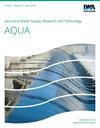以叶柏树皮甲醇提取物为原料制备植物基ZnFe2O4@TiO2磁性纳米复合材料,研究其光催化降解腐植酸的效果
IF 4.3
Q2 Environmental Science
引用次数: 0
摘要
在饮用水消毒过程中,饮用水源中的腐殖酸与含氯消毒剂发生反应,形成致突变性、缺陷性和致癌性的消毒副产物,如三卤甲烷和卤乙酸。本研究以Elaeagnus angustifolia树皮甲醇提取物为原料合成ZnFe2O4@TiO2纳米复合材料,并对纳米材料的性质、结构元素及诊断特征进行了分析。根据结果,ZnFe2O4@TiO2纳米复合材料的平均晶粒尺寸为~ 65-250 nm。此外,研究了pH(3-11)、纳米颗粒剂量(0.005-0.1 g/L)和腐植酸浓度(2-15 mg/L)在120 min内的影响。结果表明,在pH = 3,纳米复合材料剂量= 0.05 g/L,腐植酸初始浓度= 2 mg/L的条件下,腐植酸的去除率达到100%左右。研究结果表明,在腐植酸浓度最高(15 mg/L)时,纳米复合材料的效率约为95.67%。因此,可以得出结论,该纳米复合材料在具有成本效益和环境友好性的同时,也非常有效地去除水溶液中的腐植酸。本文章由计算机程序翻译,如有差异,请以英文原文为准。
Exploring efficient photocatalytic degradation of humic acid from aqueous solution with plant-based ZnFe2O4@TiO2 magnetic nanocomposite using Elaeagnus angustifolia tree bark methanolic extract
In the process of sanitizing drinking water, humic acid present in drinking water sources reacts with chlorine disinfectant and forms mutagenic, defective, and carcinogenic disinfection byproducts such as trihalomethanes and haloacetic acids. In the present study, the methanolic extract of Elaeagnus angustifolia tree bark was used for the synthesis of ZnFe2O4@TiO2 nanocomposite and then properties and structural elements and diagnostic features of nanoparticles were analyzed. According to the results, the ZnFe2O4@TiO2 nanocomposites have an average crystalline size of ∼65–250 nm. Also, the effects of pH (3–11), nanoparticle dose (0.005–0.1 g/L), and humic acid concentration (2–15 mg/L) were examined up to 120 min of time. From the results, the highest removal percentages achieved about 100% at optimal conditions (pH = 3, nanocomposite dose = 0.05 g/L and humic acid initial concentration = 2 mg/L). The results of this research showed that the efficiency of nanocomposite at the highest concentration of humic acid that was investigated in this research (15 mg/L) was about 95.67%. Therefore, it can be concluded that this nanocomposite, while being cost-effective and environmentally friendly, is also very effective in removing humic acid from an aqueous solution.
求助全文
通过发布文献求助,成功后即可免费获取论文全文。
去求助
来源期刊
CiteScore
4.70
自引率
0.00%
发文量
74
审稿时长
4.5 months
期刊介绍:
Journal of Water Supply: Research and Technology - Aqua publishes peer-reviewed scientific & technical, review, and practical/ operational papers dealing with research and development in water supply technology and management, including economics, training and public relations on a national and international level.

 求助内容:
求助内容: 应助结果提醒方式:
应助结果提醒方式:


